Much has been written about the 200,000 African American soldiers who served in the Union army during the Civil War. They were called United States Colored Troops, or USCTs. The last day of the Battle of Nashville (16 December 1864) saw the Confederate troops take up three primary positions south of the city: on the eastern or right flank were Lee’s Corps. They positioned themselves on Peach Orchard Hill. The center and left flanks were, respectively, along Granny White Pike and on top of Compton Hill (now known as Shy’s Hill). About 4:00 p.m., the Union troops under the command of Beatty and Steedman attacked Peach Orchard Hill. The fiercest fighting occurred when the trailing regiment in the 2nd Colored Brigade of Steedman’s division, the 13th United States Colored Troops, attacked the hill. The USCT regiment won the battle and forced the Confederate troops to retreat south along Franklin Pike. Gen. Hood resigned his position within weeks and the Confederate Army of Tennessee was absorbed into other Confederate units by February 1865. The Union regiment lost 220 men in the attack⏤about 40% of their strength. Documentation by Confederate generals revealed their admiration for the USCT and their bravery. They never expected the African American soldiers to fight so strongly.
More people are likely aware of the Tuskegee Airmen, or “The Red Tails” (the Mustang P-51 tails were painted red). This was a unit comprised solely of African American airmen of the United States Army Air Corps. It was during a time when the United States armed services were segregated and African American army soldiers were relegated to combat support assignments (e.g., as cooks, quartermaster, and grave digging). There were 992 Tuskegee pilots (sixty-eight killed-in-action and thirty-two became POWs). They flew a total of 1,578 combat missions destroying 262 enemy aircraft and 179 bomber escort missions. These men were awarded the Distinguished Unit Citations on three separate occasions. Other awards included one Silver Star, ninety-six Distinguished Flying Crosses, fourteen Bronze Stars, and 744 Air Medals. One of the pilots, second lieutenant Daniel “Chappie” James, Jr. (1920−1978) stayed in the Air Force and became the first African American four-star general in the United States armed forces.
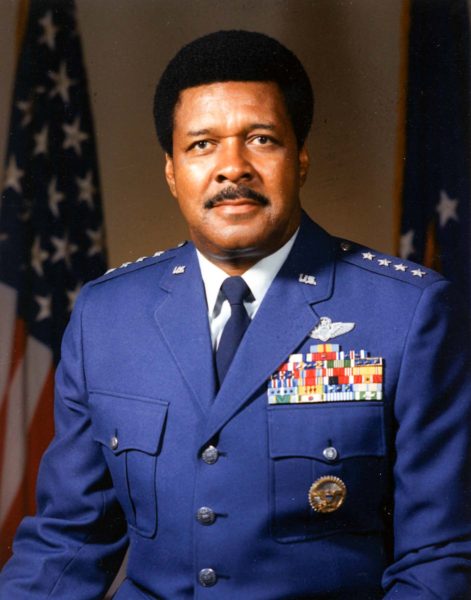

Our story today revolves around another African American military unit during World War II. This time, it involves the segregated United States Marine Corps (USMC).
Despite President Roosevelt issuing Executive Order 8802 in June 1941 prohibiting discrimination in the armed services based on “color, race, creed, or national origin,” it wouldn’t be until July 1948 when President Truman signed Executive Order 9981 ordering all of the United States military services to desegregate.
Did You Know?
Did you know that the Congressional Gold Medal and the Presidential Medal of Freedom are the highest civilian awards? Most of us are likely to be more familiar with the Presidential Medal of Freedom because it is bestowed on individuals by the president of the United States and therefore, given higher media exposure (especially when the recipient gets the honor for just being the president’s golfing buddy). The Congressional Gold Medal is awarded by the United States Congress and typically honors recipients from the military. Many of the gold medals are awarded to groups, “who have performed an achievement that has an impact on American history and culture that is likely to be recognized as a major achievement in the recipient’s field long after the achievement.” The gold medals are designed by the U.S. Mint to specifically commemorate the person(s) and achievement (i.e., there is no standard design). The medal is meant to be displayed rather than to be worn. There have been significantly fewer Congressional Gold Medals awarded compared to the Presidential Medal of Freedom. Only 163 groups, individuals, or events have been awarded a Congressional Gold Medal.

One of the groups awarded the Congressional Gold Medal is the Montford Point Camp Marines. For bravery, tenacity, and patriotism, Congress awarded the Congressional Gold Medal to twenty thousand African American marines of Montford Point Camp and in 2011, authorized President Obama to bestow the medal on the surviving former marines.
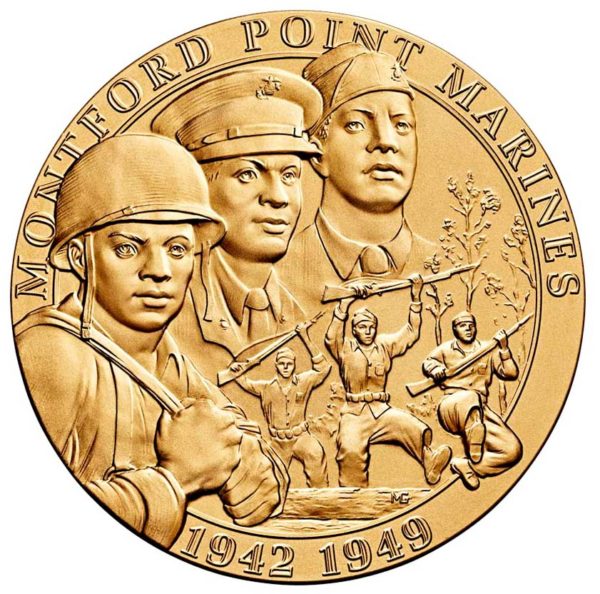
Montford Point Camp
During the early years of World War II, the commandant of the U.S. Marine Corps, General Thomas Holcomb (1879−1965), was adamantly opposed to desegregation and was on record as stating he would rather go into combat with substantially fewer white marines than a superior number of African American marines. Forced to accept African American enlistees, he decided to segregate the African American recruits by sending them to be trained (i.e., boot camp) at Montford Point Camp in North Carolina while white recruits were shipped off to Parris Island, North Carolina or San Diego. By 1949, Montford Point Camp had graduated about 20,000 African American recruits.
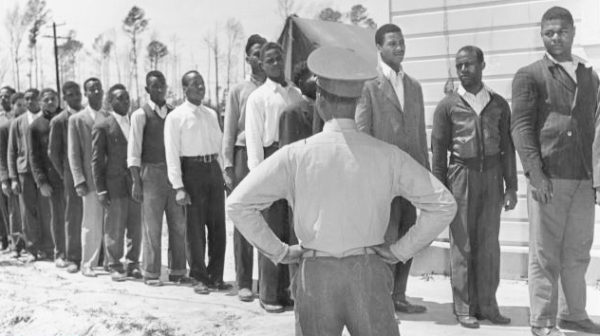
It wasn’t until 1 June 1942 that the Marine Corps began recruiting African American men between the ages of seventeen and twenty-nine. A segregated boot camp named Montford Point was established within Camp Lejeune but removed at quite a distance from the main training facility⏤African American marines were not allowed into Camp Lejeune without an escort by a white marine. The buildings at Montford Point consisted of a headquarters office, chapel, two warehouses, barber shop, library, mess hall, small steam generating plant, motor transport shed, a small officers’ club, and 120 green prefab huts to house the recruits⏤each hut held sixteen men.
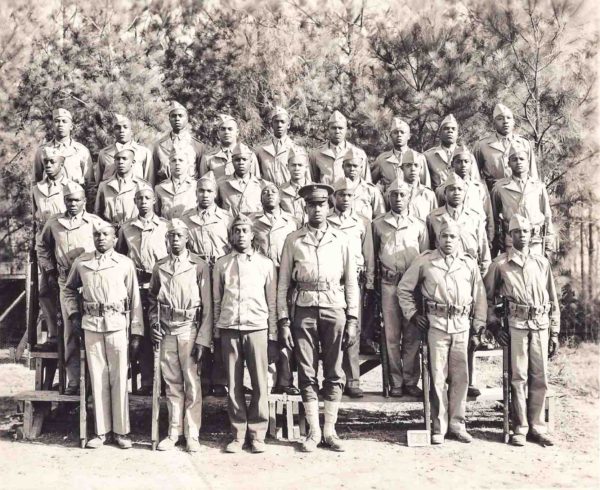
The first recruits arrived on 26 August 1942 and by January 1943, a thousand African American men were signing up each month to join the Marine Corps. Every one of them went through Montford Point for boot camp. Initially, all the officers and non-commissioned staff officers were white. However, this changed rather quickly as African American marines were promoted and placed in positions previously held by white marines. This included the drill sergeant assignment. The men thought they had it tough with their white drill sergeants and once they were replaced with African American drill sergeants, the expectation was that their training and treatment would lighten up. They were wrong. The new drill sergeants knew that their men would have a higher hill to climb than their white counterparts to prove they were combat ready. So, the training got tougher.
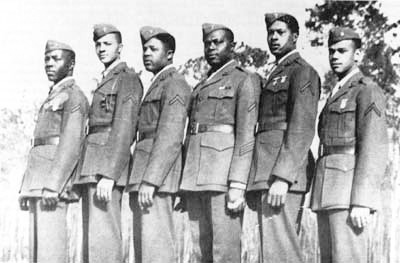
Defense Battalions
The first combat unit was formed at Montford Point in 1942. It was the 51st Defense Battalion. Shortly afterward, the Secretary of the Navy authorized the formation of the first (of sixty-three) combat support companies (i.e., depot or ammunition units) and a second battalion, the 53rd Defense Battalion. On average, two to three new combat units were activated each month between April 1943 and October 1945. More than half of the Montford Point marines were deployed overseas to fight.
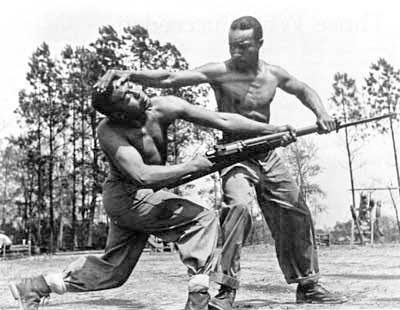
The Pacific Theater
The men of Montford Point saw action fighting the Japanese in the Pacific theater. Montford Point units were at Saipan, Guam, Tinian, Iwo Jima, and Okinawa, to name several. The last battle against the Japanese was Okinawa. The battle lasted ninety-eight days between 26 March 1945 and 2 July 1945. The Allies invaded the island on 1 April with the intent on using it as an air base to launch planes during the expected invasion of Japan. Allied casualties totaled about 50,000, Japanese casualties were estimated to be around 117,000, and civilian deaths totaled about 150,000⏤half the pre-war population of Okinawa. Because of the intensity of Japanese resistance, land fighting and subsequent casualties earned the Battle of Okinawa the reputation as the bloodiest battle in the Pacific theater during World War II.
On Okinawa, two thousand African American marines fought courageously. On Saipan, the men from Montford Point distinguished themselves to the point that the new commandant of the Marine Corps, General Alexander Vandegrift (1887−1973), exclaimed, “The Negro Marines are no longer on trial. They are Marines period.”
Disbanded
The Japanese surrendered on 15 August 1945 and World War II officially ended on 2 September when the surrender documents were signed. The first Montford Point combat unit was disbanded on 31 January 1946. During the early months of 1946, recruitment across all the armed services dropped off. Two questions needed to be addressed: how many veterans would become regulars and what would be the post-war military needs. By 1947, the Marine Corps saw the need to only enlist 1,500 African American men.
The post-war economics for the United States military was wrapped in austerity. In 1949, it was decided that Montford Point Camp was to be shut down. The original intent was to discharge all of the Montford Point marines. However, African American soldiers, marines, sailors, and airmen had distinguished themselves and proved their combat abilities forcing President Truman to order the desegregation of the armed forces by issuing Executive Order 9981. By September 1949, the remaining 272 men (officers and enlisted) of Montford Point were transferred to Camp Lejeune and this marked the beginning of the desegregation of the United States Marine Corps.
Unfortunately, the Montford Point men were never given the recognition that other African American units received (e.g., the Tuskegee Airmen and Buffalo Soldiers). It was tough enough training to be a marine let alone having to persevere against racism and discrimination at the same time.
Gunnery Sgt. Charles Shaw
Gunnery Sgt. Charles Shaw (1916−1979) was one of the first African Americans to enlist in the United States Marine Corps. Shaw was from Elgin, Texas where he was a high school teacher. Elgin, like most of the rest of the country, was a racially segregated town. He married Sarah in 1939 and had five children.
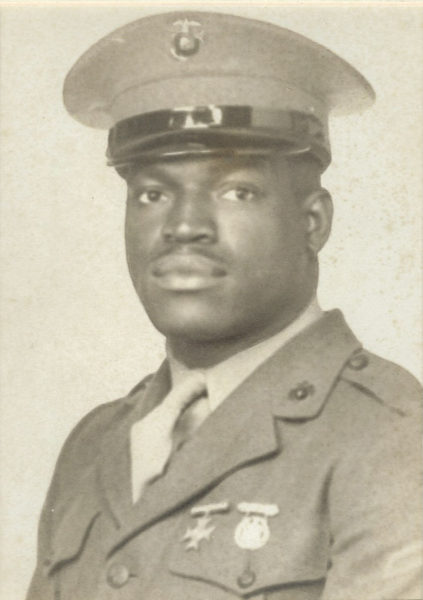
Shaw enlisted on 5 October 1943 as a private. Less than three years after enlisting, he was promoted to the rank of sergeant and served as a drill instructor. Men who served with or under Shaw described him as “equal parts tough and fair.” Standing 6’ 3” and weighing 235 pounds, Sgt. Shaw volunteered for an exhibition boxing match when Joe Louis stopped by the camp. USMC recruits soon found out that Sgt. Shaw and the other African American drill instructors held them to a higher standard than white counterparts.
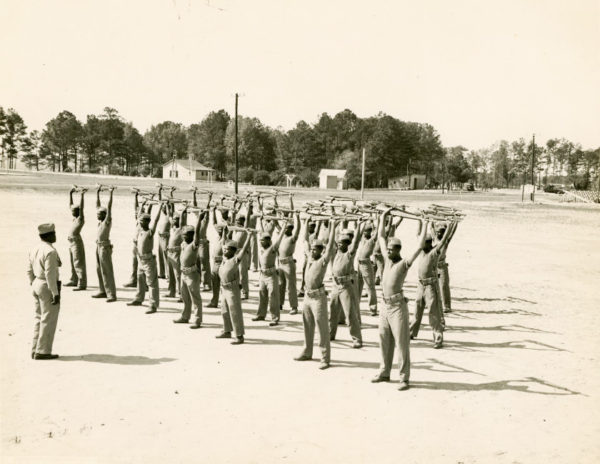
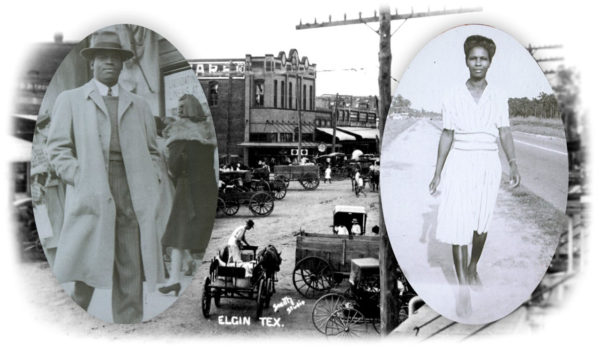
Mr. Shaw was never able to collect his Congressional Gold Medal. After mustering out of the Marines Corps, he moved his family to Santa Ana, California and became a successful businessman. Mr. Shaw passed away in 1979 but his daughter, Brenda Matthews, heard about the medal being awarded to the former Montford Point Camp marines and she wanted her father to be recognized albeit on a posthumous basis. Her journey to obtain recognition for her father ended on 10 October 2020 when Brenda and her siblings, family, and friends gathered in Yorba Linda, California for the long-awaited ceremony. Retired Marine Staff Sgt. Mike Johnson, the Montford Point Marine Association’s national vice-president handed the Congressional Gold Medal to Brenda on behalf of her father and read aloud the official citation.
Camp Gilbert H. Johnson
Sgt. Maj. Gilbert Johnson (1905−1972) was one of the USMC’s first African American recruits. In 1974, two years after Mr. Johnson passed away, Camp Lejeune was renamed Camp Gilbert H. Johnson to honor not only Sgt. Maj. Johnson but all the men who went through Montford Point Camp and served courageously in World War II.
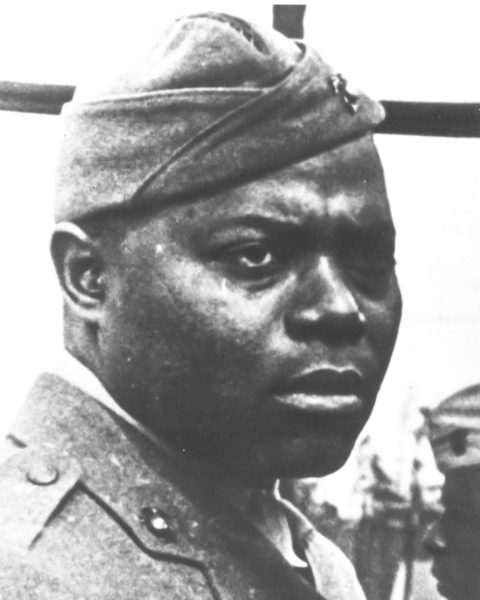
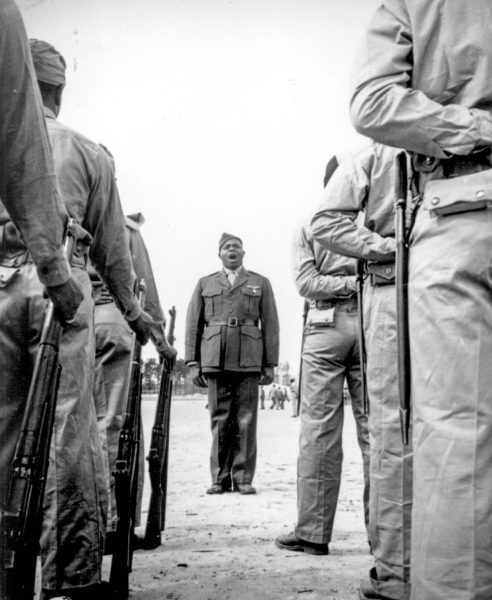
The Medal
On the reverse of the medal are the words, “For outstanding perseverance and courage that inspired social change in the Marine Corps.”
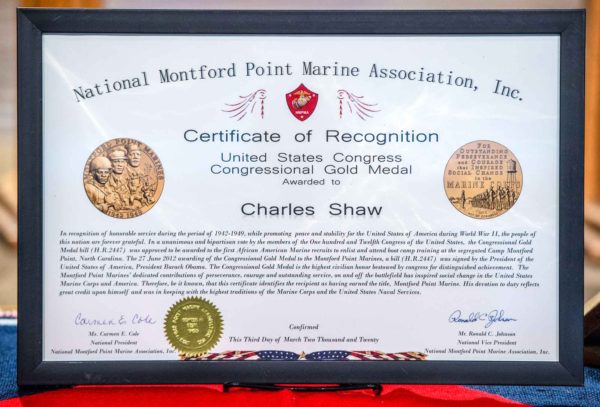
In the case of the Montford Point Camp marines and the presidential executive orders, it seems civil rights at that time were gained not in the name of liberty, but of war.
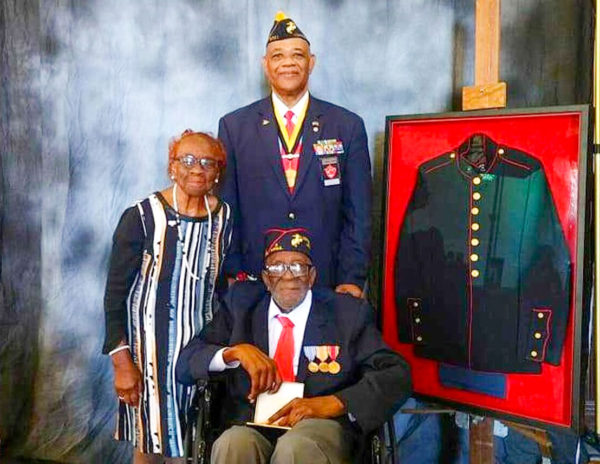
★★★ Learn More About the Montford Point Marines ★★★
Hervieux, Linda. Forgotten: The Untold Story of D-Day’s Black Heroes, at Home and at War. New York City: Harper, 2015.
McLaurin, Melton A. The Marines of Montford Point: America’s First Black Marines. Chapel Hill: University of North Carolina Press, 2009. National Montford Point Marine Association, Inc.
National Montford Point Marine Association, Inc. Click here to visit the web-site. Click here to learn about the memorial built in Jacksonville, North Carolina.
The Wounded Warrior Project. Click here to read more about the Montford Point Marines
Ziegler, Matt. Over the Side: Black Marines of WWII. Self-published, 2015.
Disclaimer:
There may be a chance that after we publish this particular blog, the video links associated with the blog are no longer accessible. We have no control over this. Many times, whoever posts the video has done so without the consent of the video’s owner. In some cases, it is likely that the content is deemed unsuitable by YouTube. We apologize if you have tried to access the link and you don’t get the expected results.
What’s New With Sandy and Stew?
Before I bring you up to date, I want to mention there is a PBS show called, “The Codebreaker” that aired on Monday, 11 January 2021. It is about Elizebeth Friedman. For those of you who read my blog, “Unit 387 & Hillsdale College,” you will recognize that name. (Click here to read the blog.) It’s about a woman who touched on many historical events by breaking coded messages. Her life story is fascinating. I’m confident the PBS show will expand on her story and provide a deeper picture than I was able to provide. Since the show aired prior to you receiving this message, I’m sure there will be reruns on PBS. Be sure to watch it (and read my blog if you haven’t already).
We are wrapping up the final manuscript for the new book, Where Did They Put the Gestapo Headquarters? A Walking Tour of Nazi Occupied Paris (1940−1944)⏤ Volume One. In the past, I have tried to keep all the books a uniform length. Although I haven’t done a word count, I have a feeling the new book will be longer than the previous four. I decided not to worry about the length. There is so much more I could put into the book and frankly, I would have a hard time trying to decide what to remove. When I began this little journey, one of my goals was to give the reader a quality product. I am confident that the new book will meet that goal and you won’t be disappointed.
Thank you to all of you who subscribe to our bi-weekly blogs. It seems there isn’t a day that goes by where we don’t increase our readership. Please let your history buff friends and family members know about our blogs.
Someone Is Commenting On Our Blogs
I’d like to thank Arnaud de L. for pointing out a mistake in my blog, Hitler’s Enablers−Part Two−The Camps. (Click here to read the blog.) The blog identifies the former Ravensbrück commandant, Fritz Suhren, having hanged after being sentenced to death. Arnaud mentioned that Suhren was executed by a firing squad since it was a French court that condemned him. There is quite a bit of conflicting information with almost all sources (including some respected historians) confirming Suhren was hanged. So, I dug a little deeper and Arnaud is correct. Suhren was tried and convicted in the French sector of Germany and after the war ended, French penal code required execution by firing squad (Suhren was executed on 12 June 1950). I have corrected the blog. Thanks again Arnaud for bringing this to my attention.
If there is a topic you’d like to see a blog written about, please don’t hesitate to contact me. I love hearing from you so keep those comments coming.
Why Would You Want to Buy Our Walking Through History Books?
Simple.
You like to travel and experience history and historical events. You like to see original buildings that had a significant impact on the people and events of the history you’re engaged with. You want to know the stories behind the brick and mortar in front of you.
The walking tour books are meticulously researched so you can go directly to those sites and learn about the building’s history as well as an introduction to some of the more interesting people associated with it.
We Need Your Help
Please tell your friends about our blog site and encourage them to visit and subscribe. Sandy and I are trying to increase our audience and we need your help through your friends and social media followers.
Thank You
Sandy and I appreciate you visiting with us. We have some exciting things on the horizon, and we’ll keep you updated as we go along.
Share This:
Follow Stew:
Find Stew’s books on Amazon and iBooks.
Please note that we do not and will not take compensation from individuals or companies mentioned or promoted in the blogs.
 Walks Through History
Walks Through History
Copyright © 2021 Stew Ross
